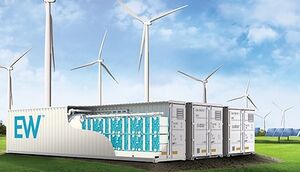Iron redox flow batteries

Iron redox flow batteries (IRFBs) are gigantic batteries made of molten iron. Each one is about the size of a shipping container, and could store energy for hundreds of homes. This is a possible solution to part of the energy storage problem - to smooth out the intermittency of wind and solar power.
Chemistry and physics
This section is incomplete. For now, read the Wikipedia page on IRFBs for a very long-winded description of how they work.
Viability
| #Need for iron | Reasonable |
| #Ready for deployment? | Maybe |
| #Usable in vehicles? | No |
Need for iron
Iron is a far more abundant metal than, say, the lithium & cobalt used in lithium-ion batteries. In fact, this is the main reason why IRFBs are being developed.
Just to confirm that iron is actually abundant enough:
Note: This is roughly the amount of on-grid energy consumption that we might need energy storage for. It consists of - for example - lighting, heating, appliances, and other energy used in homes and other buildings. We don't count industrial here, because we can assume (in principle) that most factories could operate during peak sunlight/wind, needing negligable energy storage.
The source doesn't specify whether this is steel from newly-mined iron or steel from recycling scrap. Probably it's both combined.
Source: https://dornsife.usc.edu/labs/narayan/all-iron-redox-flow-battery/
(calculation loading) (calculation loading)
Ready for deployment?
Several companies have started designing IRFBs, but there isn't a lot of info on whether they're actually being used yet.[RESEARCH needed]
For IRFBs to be useful, we still have to solve the other challenges of large-scale solar and wind. Especially solar/challenge 1: How to make enough solar panels without needing too many rare metals.
Usable in vehicles?
No. IRFBs contain molten metal, and are only safe for stationary energy storage. They can't be made small enough to fit in a car anyway